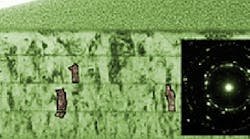Here’s a Dagwood that is sure to make any engineer’s mouth water. Scientists at the National Institute of Standards and Technology (NIST) have discovered that a carefully built “magnetic sandwich” that combines layers of a magnetic alloy with a few nanometers of silver “spacer” has dramatically enhanced sensitivity — a 400-fold improvement in some cases. This material could lead to greatly improved magnetic sensors for a wide range of applications from weapons detection and non-destructive testing to medical devices and high-performance data storage.
Those applications and many others are based on thin films of magnetic materials in which the direction of magnetization can be switched from one orientation to another. An important characteristic of a magnetic film is its saturation field, the magnitude of the applied magnetic field that completely magnetizes the film in the same direction as the applied field — the smaller the saturation field, the more sensitive the device.
The saturation field is often determined by the amount of stress in the film; atoms under stress due to the pull of bonds with neighboring atoms are more resistant to changing their magnetic orientation. Metallic films develop not as a single monolithic crystal, like diamonds, but rather as a random mosaic of microscopic crystals called grains. Atoms on the boundaries between two different grains tend to be more stressed, so films with a lot of fine grains tend to have more internal stress than coarser grained films. Film stress also increases as the film is made thicker, which is unfortunate because thick films are often required for high magnetization applications.
The NIST research team discovered that magnetic film stress could be lowered dramatically by periodically adding a layer of a metal, having a different crystal structure or lattice spacing, in between the magnetic layers. Although the mechanism isn’t completely understood, according to lead author William Egelhoff Jr., the intervening layers disrupt the magnetic film growth and induce the creation of new grains that grow to be larger than they do in the monolithic films. The researchers prepared multilayer films with layers of a nickel-iron-copper-molybdenum magnetic alloy each 100 nanometers thick, interleaved with 5-nm layers of silver. The structure reduced the tensile stress (over a monolithic film of equivalent thickness) by a factor of 200 and lowered the saturation field by a factor of 400.
The work has particular application in the design of “flux concentrators,” magnetic structures that draw in external magnetic field lines and concentrate them in a small region. Flux concentrators are used to amplify fields in compact magnetic sensors used for a wide variety of applications. For more information, visit www.nist.gov.

